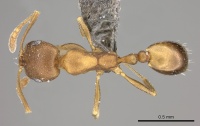Monomorium damarense
| Monomorium damarense | |
|---|---|

| |
| Scientific classification | |
| Kingdom: | Animalia |
| Phylum: | Arthropoda |
| Class: | Insecta |
| Order: | Hymenoptera |
| Family: | Formicidae |
| Subfamily: | Myrmicinae |
| Tribe: | Solenopsidini |
| Genus: | Monomorium |
| Species: | M. damarense |
| Binomial name | |
| Monomorium damarense Forel, 1910 | |
| Synonyms | |
| |
Commonly collected in more open habitats, e.g., grassland, savanna and Bushveld.
Identification
Bolton (1987) - A member of the M. australe complex in the M. salomonis species group. The extremely reduced dorsal pilosity coupled with the relatively strong cephalic sculpture and long scapes render this Namibian and Botswanan species easily recognisable. Namibian samples uniformly lack hairs on the first gastral tergite in front of the apical row, but a short series from Serowe in Botswana has a single short pair at about the midlength of the sclerite. Whether this series should be regarded as a separate species cannot be decided at present because of shortage of material with which to assess the stability of the character.
Keys including this Species
Distribution
Latitudinal Distribution Pattern
Latitudinal Range: -16.13333° to -28.43882°.
| North Temperate |
North Subtropical |
Tropical | South Subtropical |
South Temperate |
- Source: AntMaps
Distribution based on Regional Taxon Lists
Afrotropical Region: Botswana, Namibia (type locality).
Distribution based on AntMaps
Distribution based on AntWeb specimens
Check data from AntWeb
Countries Occupied
| Number of countries occupied by this species based on AntWiki Regional Taxon Lists. In general, fewer countries occupied indicates a narrower range, while more countries indicates a more widespread species. |

|
Estimated Abundance
| Relative abundance based on number of AntMaps records per species (this species within the purple bar). Fewer records (to the left) indicates a less abundant/encountered species while more records (to the right) indicates more abundant/encountered species. |

|
Biology
Castes
Images from AntWeb
 
| |
| Worker. Specimen code casent0235922. Photographer Shannon Hartman, uploaded by California Academy of Sciences. | Owned by AFRC, Pretoria, South Africa. |
Nomenclature
The following information is derived from Barry Bolton's Online Catalogue of the Ants of the World.
- damarense. Monomorium salomonis subsp. damarense Forel, 1910f: 17 (w.) NAMIBIA.
- Type-material: syntype workers (number not stated).
- Type-locality: Namibia: Damaraland, Gawieb (L. Schultze).
- Type-depository: MHNG.
- Subspecies of salomonis: Arnold, 1916: 223; Wheeler, W.M. 1922a: 870; Emery, 1922e: 178; Ettershank, 1966: 88.
- Status as species: Santschi, 1936a: 39; Marsh, 1986: 339; Bolton, 1987: 340 (redescription); Bolton, 1995b: 260.
- Senior synonym of unicolor: Bolton, 1987: 340; Bolton, 1995b: 260.
- Distribution: Botswana, Namibia.
- unicolor. Monomorium salomonis var. unicolor Stitz, 1923: 156 (w.) NAMIBIA.
- Type-material: 6 syntype workers.
- Type-locality: Namibia: Omaruru, 21-22.vi.1911 (W. Michaelsen).
- Type-depository: MNHU.
- Subspecies of salomonis: Ettershank, 1966: 93.
- Junior synonym of damarense: Bolton, 1987: 340; Bolton, 1995b: 268.
Median portion of clypeus with anterior margin transverse to shallowly concave. Maximum diameter of eye 0.27-0.31 x HW, with 7-9 ommatidia in the longest row. Scapes relatively long (SI > 105), longer than any other species included in the australe-complex. Metanotal groove feebly impressed in profile. Dorsum of head without standing hairs behind the level of the frontal lobes. Dorsal alitrunk without standing hairs. Petiole node without hairs but postpetiole with a single backward directed pair. First gastral tergite with minute appressed pubescence but usually without hairs except for the apical transverse row. Dorsum of head opaque , blanketed with very fine and dense reticulate-shagreenate to striolate-punctulate or granulate-punctulate sculpture; close to the occipital margin the sculpture may appear feebly reticulate-punctulate. Pronotal dorsum finely reticulate, the sculpture becoming more intense posteriorly on the dorsal alitrunk so that the propodeum is superficially reticulate-punctulate. First gastral tergite with superficial reticular patterning, which is overlaid by fine shagreening basally. Colour light brown to medium brown.
Type Material
Bolton (1987) - Syntype workers, Namibia: Damaraland, Gawieb (L. Schultze) (Musee d'Histoire Naturelle Genève) [examined].
References
- Bolton, B. 1987. A review of the Solenopsis genus-group and revision of Afrotropical Monomorium Mayr (Hymenoptera: Formicidae). Bulletin of the British Museum (Natural History). Entomology. 54: 263-452.. (page 340, Raised to species, and senior synonym of unicolor)
- Forel, A. 1910e. Zoologische und anthropologische Ergebnisse einer Forschungsreise im westlichen und zentralen Südafrika ausgeführt in den Jahren 1903-1905 von Dr. Leonhard Schultze. Vierter Band. Systematik und Tiergeographie. D) Formicidae. Denkschr. Med.-Naturwiss. Ges. Jena 16: 1-30 (page 17, worker described)
- Santschi, F. 1936a. Étude sur les fourmis du genre Monomorium Mayr. Bull. Soc. Sci. Nat. Maroc 16: 32-64 (page 39, see also)
References based on Global Ant Biodiversity Informatics
- Arnold G. 1916. A monograph of the Formicidae of South Africa. Part II. Ponerinae, Dorylinae. Annals of the South African Museum. 14: 159-270.
- Bolton B. 1987. A review of the Solenopsis genus-group and revision of Afrotropical Monomorium Mayr (Hymenoptera: Formicidae). Bulletin of the British Museum (Natural History). Entomology 54: 263-452.
- IZIKO South Africa Museum Collection
- Marsh A. C. 1986. Ant species richness along a climatic gradient in the Namib Desert. Journal of Arid Environments 11: 235-241.
- Marsh A. C. 1986. Checklist, biological notes and distribution of ants in the central Namib Desert. Madoqua 14: 333-344.
- Stitz H. 1923. Hymenoptera, VII. Formicidae. Beiträge zur Kenntnis der Land- und Süsswasserfauna Deutsch-Südwestafrikas 2: 143-167.
- Wheeler W. M. 1922. Ants of the American Museum Congo expedition. A contribution to the myrmecology of Africa. VIII. A synonymic list of the ants of the Ethiopian region. Bulletin of the American Museum of Natural History 45: 711-1004

